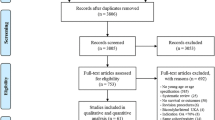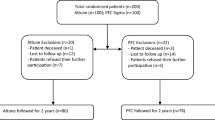Abstract
Both primary total hip (THA) and knee (TKA) arthroplasty relieve pain, restore function, and increase mobility. Despite these successes, there is controversy as to whether THA or TKA provides greater or similar improvement. We therefore compared primary THA and TKA patient results in terms of (1) willingness to have surgery again; (2) WOMAC change score; (3) whether expectations were met; and (4) satisfaction. Patients undergoing primary THA were more willing to undergo their surgery again (THA 96%, TKA 89%), demonstrated greater WOMAC change scores, more frequently reported their expectations were met (THA 78%, TKA 70%), and expressed greater overall satisfaction (THA 89%, TKA 81%). In addition, patients undergoing THA expressed higher satisfaction with pain reduction while performing activities (ie, walking, stairs, and sitting/lying) and their ability to perform daily activities (ie, stairs, transportation, getting up, lying in bed, and light domestic duties) when compared with patients undergoing TKA. Our data suggest primary THA offers superior short-term outcomes when compared with primary TKA.
Level of Evidence: Level II, prognostic study. See Guidelines for Authors for a complete description of levels of evidence.
Similar content being viewed by others
References
American Society of Anesthesiologists (ASA). Physical status score. Available at: http://www.asahq.org/physicalstatus.htm. Accessed February 21, 2006.
Anderson JG, Wixson RL, Tsai D, Stulberg SD, Chang RW. Functional outcome and patient satisfaction in total knee patients over the age of 75. J Arthroplasty. 1996;11:831–840.
Bellamy N. WOMAC: a 20-year experiential review of a patient-centered self-reported health status questionnaire. J Rheumatol. 2002;29:2473–2476.
Bellamy N. WOMAC Osteoarthritis Index: A User’s Guide IX. London, Ontario, Canada: Professor Nicholas Bellamy; 2009.
Bellamy N, Buchanan WW, Goldsmith CH, Campbell J, Stitt LW. Validation study of WOMAC: a health status instrument for measuring clinically important patient relevant outcomes to antirheumatic drug therapy in patients with osteoarthritis of the hip or knee. J Rheumatol. 1988;15:1833–1840.
Bourne RB, McCalden RW, MacDonald SJ, Mokete L, Guerin J. Influence of patient factors on TKA outcomes at 5 to 11 years follow-up. Clin Orthop Relat Res. 2007;464:27–31.
Bourne RB, Sibbald WJ, Doig G, Lee L, Adolph S, Robertson D, Provencher M. The Southwestern Ontario Joint Replacement Pilot Project: electronic point-of-care data collection. Southwestern Ontario Study Group. Can J Surg. 2001;44:199–202.
Chesworth BM, Mahomed NN, Bourne RB, Davis AM. Willingness to go through surgery again validated the WOMAC clinically important difference from THR/TKR surgery. J Clin Epidemiol. 2008;61:907–918.
Dillman D. Mail and Electronic Surveys: The Tailored Design Method. New York, NY: John Wiley; 2000.
Escobar I, Quintana JM, Bilboa A, Arostegai I, Lafuente I, Vidarreta I. Responsiveness and clinically important differences for WOMAC and SF-36 after total knee replacement. Osteoarthritis Cartilage. 2007;15:273–280.
Ethgen O, Bruyere O, Richy R, Dardenne C, Reginster JV. Health-related quality of life in total hip and knee arthroplasty. A qualitative and systemic review of the literature. J Bone Joint Surg Am. 2004;86:963–974.
Fortin PR, Clarke AE, Joseph L, Liang MH, Tanzer M, Ferland D, Phillips C, Partridge AJ, Belisle P, Fossel AH, Mahomed N, Sledge CB, Katz JN. Outcomes of total hip and knee replacement. Preoperative functional status predicts outcomes at six months after surgery. Arthritis Rheum. 1999;42:1722–1728.
Guideline for Wait Time Thresholds for Total Hip and Knee Replacement Surgery Based on Severity. Detailed Report. London, Ontario: Ontario Joint Replacement Registry; 2006.
Janse AJ, Gemke RJ, Uiterwaal CS, van der Tweel I, Kimpen JL, Sinnema G. Quality of life: patients and doctors don’t always agree; a meta-analysis. J Clin Epidemiol. 2004;57:653–661.
Jones CA, Voaklander DC, Suarez-Almazon ME. The effect of age on pain, function and quality of life after total hip and knee arthroplasty. Arch Intern Med. 2001;161:454–460.
Laupacis A, Bourne RB, Rorabeck CH, Feeny D, Wong G, Tugwell P, Leslie K, Bullas R. The effect of elective total hip replacement on health-related quality of life. J Bone Joint Surg Am. 1993;75:1619–1629.
Mahomed N, Sledge CB, Daltroy L, Fossel A, Katz J. Self-administered satisfaction scale for joint replacement arthroplasty. J Bone Joint Surg Br. 1998;80:63–69.
Mahomed NN, Liang MH, Cook EF, Daltroy LH, Fortin PR, Fossel AH, Katz JN. The importance of patient expectations in predicting functional outcomes after total joint arthroplasty. J Rheumatol. 2002;29:1273–1279.
Quintana JM, Escobar A, Bilbao A, Arostegai I, Lafuente I, Vidaurreta I. Responsiveness and clinically important differences for the WOMAC and SF-36 after hip joint replacement. Osteoarthritis Cartilage. 2005;13:1076–1083.
Rorabeck CH, Bourne RB, Laupacis A, Feeny D, Wong C, Tugwell P, Leslie K, Bullas R. A double-blind study of 250 cases comparing cemented with cementless total hip arthroplasty. Cost effectiveness and its impact on health-related quality of life. Clin Orthop Relat Res. 1994;298:156–164.
Acknowledgments
We thank Mrs Susan Warner, Managing Director of the Ontario Joint Replacement Registry, and the Ontario orthopaedic surgeons who participated in the Ontario Joint Replacement Registry.
Author information
Authors and Affiliations
Corresponding author
Additional information
One or more of the authors (RBB, BC, AD, NM, KC) have received research funding but no personal financial support from the Ontario Ministry of Health and Long Term Care.
Each author certifies that his or her institution has approved the reporting of these cases, that all investigations were conducted in conformity with ethical principles of research, and that informed consent for participating in the study was obtained.
About this article
Cite this article
Bourne, R.B., Chesworth, B., Davis, A. et al. Comparing Patient Outcomes After THA and TKA: Is There a Difference?. Clin Orthop Relat Res 468, 542–546 (2010). https://doi.org/10.1007/s11999-009-1046-9
Received:
Accepted:
Published:
Issue Date:
DOI: https://doi.org/10.1007/s11999-009-1046-9




